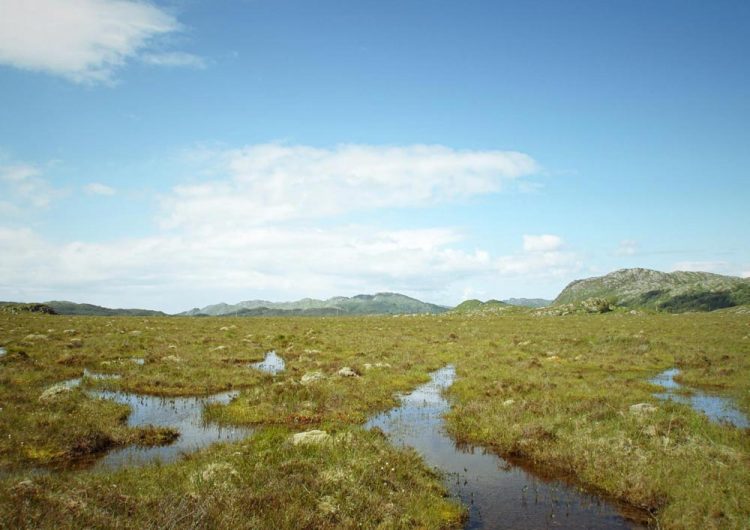Crucial peatlands carbon-sink vulnerable to rising sea levels

Crucial peatlands carbon-sink vulnerable to rising sea levels. Credit: Alex Whittle / University of Exeter
Rising sea-levels linked to global warming could pose a significant threat to the effectiveness of the world's peatland areas as carbon sinks, a new study has shown.
The pioneering new study, carried out by Geographers at the University of Exeter, examined the impact that salt found in sea water has on how successfully peatland ecosystems accumulate carbon from the atmosphere.
The researchers studied an area of blanket bog – a peat bog that forms in cool regions susceptible to high rainfall – at Kentra Moss, in Northwest Scotland.
They discovered that the rate at which the peatland area accumulated carbon was significantly impacted as the concentration of salt rose.
The results indicate that rising sea levels, linked to predicted climate change, could pose a serious threat to the future security of the peatlands because they would inundate areas and deposit more salt, further inland.
The findings feature in respected scientific journal, Scientific Reports, on Wednesday, June 29, 2016.
Dr Angela Gallego-Sala, co-author of the paper and a Senior Lecturer in Physical Geography at Exeter said: “Peatland areas play a crucial role in taking carbon from our atmosphere and storing it”.
“We know that rising sea levels through global warming can have catastrophic effects on many areas across the globe, and this study shows just how vulnerable some peatland areas are to the same phenomenon.
“The effects of global warming are already being observed, but the longer we wait to act, the quicker changes to our environment, which would have a devastating impact on many regions around the world, will take place.”
Rain-fed peatlands are recognised as being a globally important environmental resource because they absorb and store carbon.
Their unique plant communities and their inherent wetness are known to help control their ability to act as carbon stores. However, this new research shows that there is a threshold concentration of salt above which, the plant communities are less successful at absorbing and storing carbon from the atmosphere.
Blanket bogs, such as the one used for the study, are distinctive peatland ecosystems occupying specific coastal, high-latitude areas, making them vulnerable to sea-level change.
The study, which arose from an undergraduate research project carried out by student Alex Whittle and Dr Gallego-Sala, looked at the age and density of carbon that was stored in core samples taken in three specific areas, starting next to the coastline and moving progressively inland.
The samples showed that as salt levels increased, the vegetation that colonise the bogs altered significantly, resulting in a sharp decline in carbon storage. The research suggests that if sea levels rise and blanket bogs receive more salt-water, so the rate at which carbon can be stored will sharply decline.
Alex Whittle, author of the paper and now a research student in the Department of Geography said: “This study highlights the global scale and geographical distribution of peatlands potentially vulnerable to sea-level change. We hope our work will increase awareness of this risk and thereby stimulate future research on this topic”.
Dr Gallego-Sala added: “What started out as an undergraduate project has led to a ground-breaking new study, and produced some startling results. Peatland areas are vital for our ecosystems and hopefully this study will help give us a greater understanding of the threats that they are facing in the future.”
Vulnerability of the peatland carbon sink to sea-level rise, by Alex Whittle and Angela Gallego-Sala, is published in Scientific Reports.
Media Contact
All latest news from the category: Earth Sciences
Earth Sciences (also referred to as Geosciences), which deals with basic issues surrounding our planet, plays a vital role in the area of energy and raw materials supply.
Earth Sciences comprises subjects such as geology, geography, geological informatics, paleontology, mineralogy, petrography, crystallography, geophysics, geodesy, glaciology, cartography, photogrammetry, meteorology and seismology, early-warning systems, earthquake research and polar research.
Newest articles

A ‘language’ for ML models to predict nanopore properties
A large number of 2D materials like graphene can have nanopores – small holes formed by missing atoms through which foreign substances can pass. The properties of these nanopores dictate many…

Clinically validated, wearable ultrasound patch
… for continuous blood pressure monitoring. A team of researchers at the University of California San Diego has developed a new and improved wearable ultrasound patch for continuous and noninvasive…

A new puzzle piece for string theory research
Dr. Ksenia Fedosova from the Cluster of Excellence Mathematics Münster, along with an international research team, has proven a conjecture in string theory that physicists had proposed regarding certain equations….



